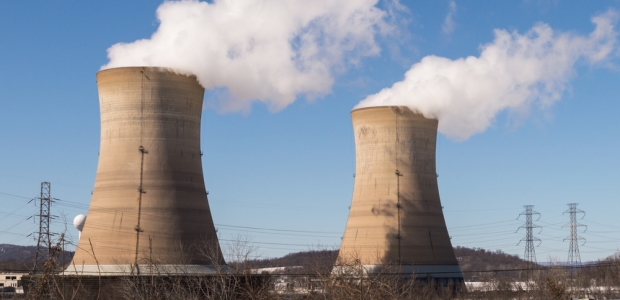
EIA Meeting to Examine Future of U.S. Nuclear Power
The 2017 EIA Energy Conference taking place June 26-27 will include a session on the future of nuclear power, examining the competitive challenges facing existing plants and the options available to plant owners and regulators.
The announcement by Exelon Corporation late last month that it will "prematurely retire" its Three Mile Island Generating Station two years from now, barring state legislative relief, is not the only worrisome sign on the horizon for the U.S. nuclear power industry. The U.S. Energy Information Administration highlighted that development on its website June 13 in an article pointing out that five other nuclear plants have been retired in the past four years and six more are scheduled to retire within the next nine years.
"Economic factors have played a significant role in the decisions affecting the continued operation or retirement of nuclear power plants, as increased competition from natural gas and renewables has made it harder for nuclear generators to compete given slowing electricity demand growth," EIA noted. "In the announcement of its plan to retire Three Mile Island, Exelon noted that the plant had not been profitable for the past five years, and they sought subsidies from Pennsylvania to provide the financial support necessary to keep the plant open. New York and Illinois have already enacted programs to provide financial support to selected nuclear plants. Those programs are currently subject to legal challenges that have yet to be adjudicated.
"Prior to the retirement of the Crystal River, Kewaunee, and San Onofre nuclear power plants in 2013, no nuclear reactor had been retired since 1998," the article stated. "Since 2013, two more plants—Vermont Yankee in 2014 and Nebraska's Fort Calhoun in 2016—have retired. In total, the five nuclear plants that retired in the past four years had a combined capacity of nearly 5,000 megawatts (MW). In most of those cases, increased electricity generation from natural gas and coal made up for the reduced nuclear output in the months following nuclear plant shutdowns. In addition to these recent retirements, six plants are scheduled to retire within the next nine years. Four of these—Palisades, Pilgrim, Oyster Creek, and Three Mile Island—have planned retirement dates more than a decade before their operating licenses expire. New nuclear plants are licensed to operate by the Nuclear Regulatory Commission for 40 years, but nearly 90% of currently operating nuclear power plants have applied for and received license extensions to operate for another 20 years. Entergy, the owner of Indian Point, had initially applied for a license extension for the plant. When the extension was challenged by the state of New York because of environmental and safety concerns, Entergy announced its decision to retire the plant. Pacific Gas & Electric, the owner of Diablo Canyon, chose not to seek a license extension, and the company now plans to retire the plant by the time its license expires."
EIA is hosting its 2017 Energy Conference in Washington, D.C., June 26-27, and it will include a session on the future of nuclear power, examining the competitive challenges facing existing plants and the options available to plant owners and regulators.
There are currently 99 nuclear reactors at 60 nuclear power plants operating in the United States. "Since the first commercial U.S. nuclear reactor came online in 1957, more than 30 nuclear reactors have retired. Some of these retired plants were test projects or experimental designs, but most provided commercial power for some portion of their operational lives," EIA reported.
The conference's panel on the future of nuclear power will be moderated by Greg Adams, who leads EIA's Coal and Uranium Analysis team. Speakers on the panel are scheduled to include Edward Kee, CEO of the Nuclear Economics Consulting Group; Chris Mudrick, senior VP for Northeast Operations, Exelon; and Bradley Williams, senior advisor for the U.S. Department of Energy's Office of Nuclear Energy.
On June 13, the Nuclear Regulatory Commission announced that an NRC Atomic Safety and Licensing Board will hold a teleconference June 20 to hear oral arguments on a hearing request regarding Florida Power & Light's application for two new reactors at the Turkey Point site. (The board is an independent body within NRC that conducts adjudicatory hearings and renders decisions on legal challenges to licensing actions.) The board will hear arguments on the admissibility of a new contention filed by the City of Miami, the Village of Pinecrest, and the City of South Miami that challenges whether FPL has the financial ability to complete the proposed project.
Separately, The Arizona Republic's Ryan Randazzo reported June 13 that the Palo Verde Nuclear Generating Station west of Phoenix kept running after an explosion left a backup generator out of service. "Experts at the Nuclear Regulatory Commission disagreed strongly over whether the plant should have been allowed to keep running during the repairs, according to documents leaked to the Union of Concerned Scientists, a watchdog group," he wrote, adding that the NRC usually allows a nuclear plant 10 days to make such repairs but in this case, NRC granted the plant's operator, Arizona Public Service Co., two extensions, which NRC officials said followed a careful review of the risks.
"But not everyone at the agency agreed with the decision. NRC employees filed three dissents that were given to The Arizona Republic by the scientist watchdog group. The NRC subsequently released one of the documents, a petition asking for the time extensions to be revoked," Randazzo reported.